
The San Juan Mountains are easily some of the most beautiful mountains in the entire United States. Colorado really has been blessed with some amazing country. The area continues to grow, and more and more people are looking to get out and explore to see what this amazing state has to offer.
Colorado might have more gold prospecting opportunities than any other state. It easily rivals any of the western states simply in the amount of different areas where gold has been found. The area that we are going to focus on in this article is the rich mining region around Ouray, Silverton and Telluride. These are old mining camps that boomed once rich mineral ores were discovered.
Since this is now a popular tourist area now, there are several fun opportunities for “casual prospectors” to do a little gold panning without needing to buy equipment or do any real research. There are also some amazing underground mine tours worth seeing! We will cover a few of these different options below.
For the more adventurous, I will tell you now that there are some excellent prospecting opportunities in the San Juan Mountains, and some of the best areas will require some hiking and a bit of research to find. The result might be a considerable amount of gold, but you need to come prepared. Let’s dive right in and see what this region has to offer!
Bachelor Syracuse Mine Tour
About 3 miles north of Ouray is the Bachelor Syracuse Mine. At one time this was one of the biggest mines in the San Juan Mountains, producing thousands of ounces of both gold and silver. 150 years later, it is a popular tourist attraction that allows visitors to see what life was like for miners back then. You will get a guide tour, learn about some of the mine history, and take a walk deep into one of the underground adits.
This mine is one of the good kid-friendly or “casual prospecting” options. You’ll get a chance to do some panning at the mine, and if you’re lucky you might find a flake or two of that lovely precious metal.
Uncompahgre River
The Uncompahgre River starts in the high country just south of Ouray, flows right through town and continues north on its journey to the Gunnison River. You can find gold all throughout the 75 mile stretch of the river, just be aware that a good number of those miles are through private land.
There are a few access points that are worth exploring. One of special note is just north of Ouray at the Riverwalk Park. This provides access to about a mile of the Uncompahgre River. This is a maintained trail owned by the town so you can use to access the river and do some gold panning. Just make sure that you are within the park boundaries.
The gold here – like much of Colorado’s gold – is very fine. If you are sloppy with your panning technique you are likely to lose that fine gold. As you venture north along the river you will fine several more parks that provide access to the river. Casual prospecting is generally allowed, but be respectful of any rules posted and leave the area better than you found it.
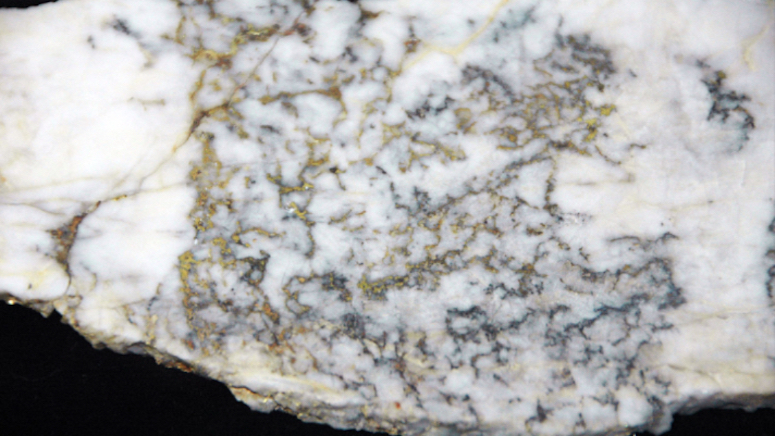
This is a sample of high-grade gold/quartz ore from a mine near Ouray. This is the type of material that you can find searching old tailing piles with a metal detector.
Silverton’s Mayflower Mill
While this isn’t a prospecting opportunity, it is worth mentioning because it is such a neat place to visit. The Mayflower Mill was the largest mining mill in the San Juan Mountains. Over a span of 49 years it was in operation it processed over 2 million ounces of gold and 30 million ounces of silver! These ores came from the many mines throughout the San Juans.
The Mill fell into disrepair during the past few decades, but was beautifully restored in recent years. You can stop and take a tour of the facility that was one of the most important ore processors in Southwestern Colorado. This is just one of many historical sites worth visiting. Check out the links at the bottom of this article for more ideas of places to visit.
Old Hundred Mine Tour
Just like at the Bachelor Syracuse Mine, this is an opportunity to venture deep underground and explore an old mine. The Old Hundred Mine is about 5 miles east of Silverton. You can take a tour over 1/3 of a mile deep into the mountain and learn about how gold and silver were extracted from the hard rock.
It was really silver that really brought the early miners to the Silverton area. Gold was also mined from most of the ores as a by-product, but without the silver most of them would not have been economically viable.
This is another chance to dip a gold pan in the water. At the Old Hundred Mine they have a “sluice box” set up where you can do a bit of panning. They advertise that you might find a copper, silver or gold. The price of admission for the mine tour gets you access the the gold panning. Another great option for kids!
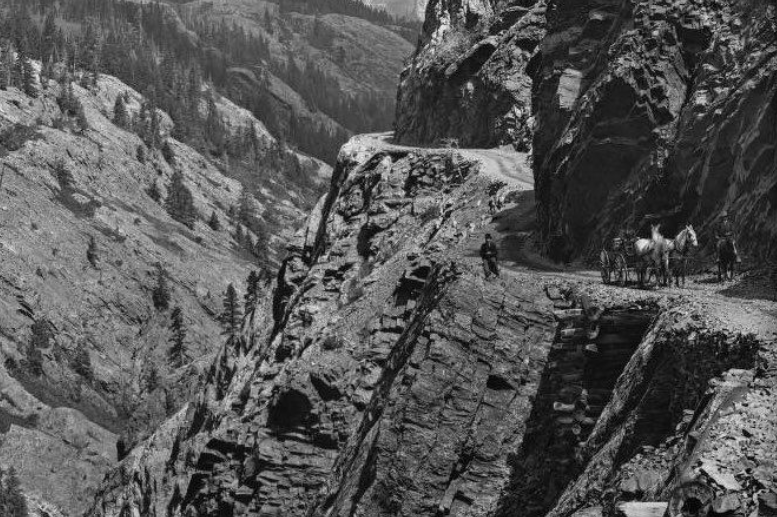
A treacherous toll road connecting Ouray and Silverton.
Animas River
As you might expect, the Animas River that flows from the high country in Silverton has gold throughout. Even all the way down to Durango can produce a bit of “color” in the bottom of your pan. I wouldn’t expect much in the way of big nuggets… the gold here is fine textured and will take some level of expertise the recover. Pan slowly and carefully to get those tiny specks.
The river flows through many miles of public land (more downstream of Silverton than upstream) that you should be able to find some access for a bit of gold panning. There are also a few small parks at various locations around Durango and Silverton that you can get to the river.
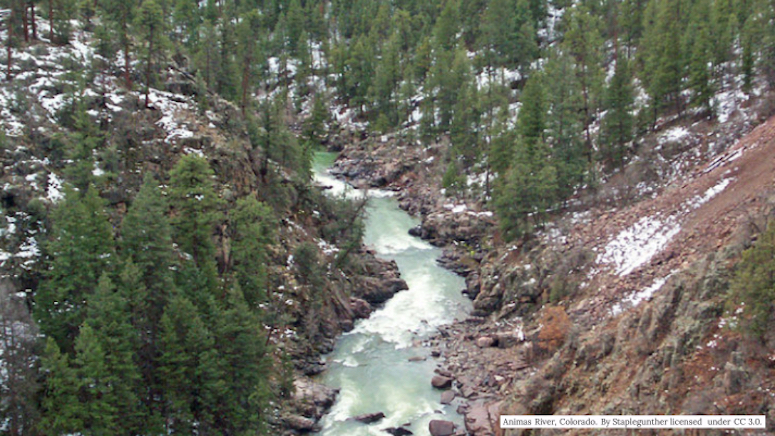
San Miguel River
Telluride is yet another old silver mining camp that transformed into one of the major silver producers of the San Juan Mountains. Old mines and mill sites are scattered throughout the high peaks that surround the town. Many of the mines in Telluride were attractive because there was considerable gold as well as silver. Countless hard rock mines extracted these minerals and made it a rowdy boomtown.
Now it is a popular destination for tourists, but just like Ouray and Silverton, it was the mines that got everything started.
Yet another place that you can expect to find some gold is the San Miguel River. There are several places to access the river right in the city of Telluride. In fact, there are several accesses that you can get to the river between Telluride downstream toward Sawpit. These are parks and land owned by the city and county. The Sawpit Town Park is another access that you can try a little panning. These areas can get rather busy during prime tourist season.
Fun Fact: Butch Cassidy’s first bank robbery was in Telluride. In 1889 he got away with $24,000 from the San Miguel Valley Bank.
The High Mountain Creeks
I have highlighted some of the major gold-bearing rivers in this area, but truthfully there are so many small creeks and tributaries that are also also full of gold. They are honestly too plentiful to list.
This part of the San Juan Mountains is simply one of the richest regions in the entire state of Colorado. There are countless lode mines that have shed gold from their hard rock sources and fed smaller gold into the waterways. I think you’d be hard-pressed to find a creek in this are that doesn’t have at least a little bit of gold.
Finding gold in the mountains is for the serious prospector because in many cases you will be venturing off the main roads and doing some hiking. These are extremely high elevations where oxygen can feel thin if you aren’t use to it. Only venture into the backcountry if you are prepared for it.
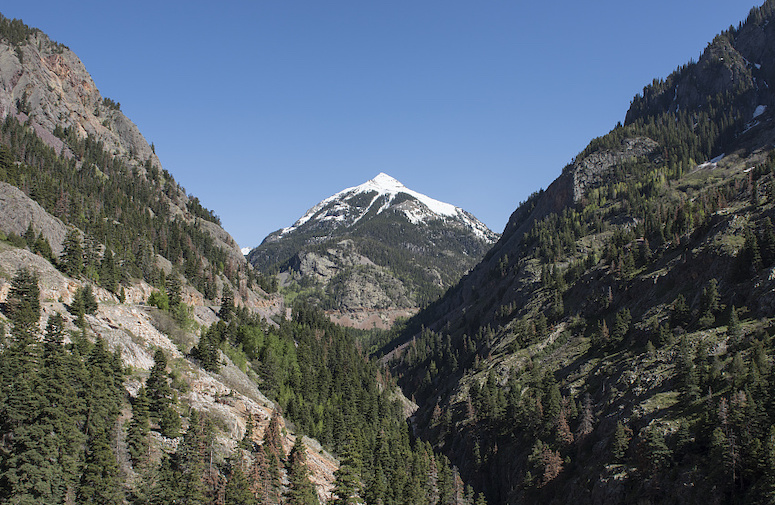
Abandoned Mines
Up until now, we’ve been talking a lot about the placer gold that you can find in the rivers and streams. The high mountains all around Ouray, Silverton and Telluride also have hundred and hundreds of old mines that you can explore. And there are literally thousands more smaller prospects (where miners may have done a bit of digging but didn’t establish a mine). Many of these mines will have waste piles of unprocessed ores. Some of this was waste material of little value. Sometimes it was considered “low grade” and wasn’t worth transporting to the mill. Other times, for whatever reason the mines were shut down and the ore remained unprocessed.
A person can find gold in these abandoned ore piles. I won’t tell you that it’s easy, but there is gold to be found and sometime it can be large pieces that are quite valuable. Sometimes the gold is in crystalline form and commands a top price from rare mineral collectors.
Finding these beautiful specimens is best done using a sensitive very-low frequency metal detector. I now recommend the Minelab Equinox 800 because it is fairly easy for beginners to learn and it is very sensitive. It is killer detectors on small, crystalline gold specimens and also works great for coins and relics at old mining camps.
I must note that anytime you are around old mines, be extremely careful to avoid open shafts and old abandoned building and equipment. Never go underground in an abandoned mine if you are not qualified or being guided by a professional. You don’t need to go underground to find the gold; its usually located in waste rock piles already on the surface.

The Camp Bird Mine was a rich gold producer in the mountains between Ouray and Telluride. It is just one amongst the hundreds of abandoned mines in this region.
Private Claims & Open Ground
There are lots of places that you can prospect in this area. There are also lots of areas that are off-limits, so you need to be aware of this. Private lands and mining claims are not open to the general public for prospecting. Many of the old mine site are on patented mining claims that are not accessible. Don’t go where you aren’t suppose to and respect private property.
Since most people who visit this area are simply looking for a fun, easy way to do a bit of panning, consider one of the guided mine tours or public park accesses to the rivers. These are great places to do a little digging in the dirt without any troubles.
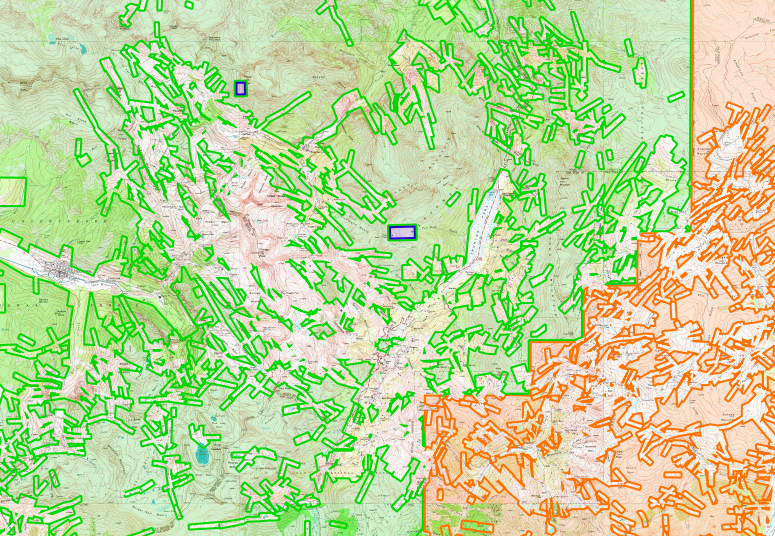
This map shows landownership in the Telluride/Ouray area. There is a patchwork of Forest Service (green), BLM (orange) and Private (white) represented on this map. Those zigzag white lines on the map are all patented mines. There are hundreds and hundreds of them in this area. This really gives you an idea of the richness if these mountains. It’s also a good reminder that you need to take the proper precautions so that you know where you are allowed to prospect.
So Much to Explore Here!
One thing that Colorado really does right is to embrace its mining history. This state was build on gold and silver! If you are a history buff that wants to learn more about the past there is no shortage of things to see. Here are a just a few places to consider visiting…
San Juan County Historical Society
Mining in Colorado – Richest Counties for Gold Prospecting

